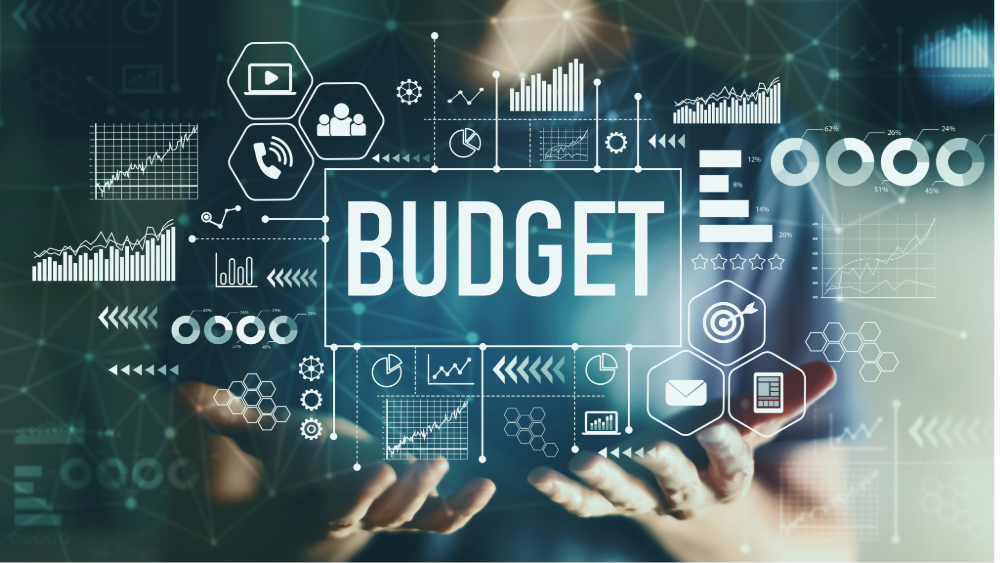Budgeting is the cornerstone of financial health, providing individuals with a roadmap to manage income and expenses effectively. In today’s economy, mastering the art of budgeting is practical and essential for achieving financial stability and meeting your goals. Continue reading to learn budgeting tips that can empower you to take charge of your finances and build a solid foundation for economic success.
Tip 1: Track Your Expenses
Understanding where your money goes is crucial for financial stability and growth. It allows you to make informed decisions about spending, saving, and investing. By tracking expenses, you can identify areas where you may be overspending and make adjustments to achieve credit and financial goals more effectively.
Tracking your expenses is crucial for creating and sticking to a budget, which is the first step in managing debt, building savings, and planning for the future. Ultimately, knowing where your money goes empowers you to take control of your finances and work toward a more secure financial future.
Tip 2: Create a Realistic Budget
Setting up a budget based on income and expenses involves a few key steps. First, calculate your total monthly income from all sources. Next, list all your monthly expenses, categorizing them into fixed costs, like rent, and variable costs, like groceries and entertainment.
Subtract your total expenses from your income to determine your discretionary income. Allocate this toward savings, debt repayment, and other financial goals. Regularly review and adjust your budget to reflect any changes in income or expenses, ensuring it remains realistic and effective in managing your own finances. Diligently following a budget can help you better control your spending and achieve your financial goals.
Tip 3: Prioritize Debt Repayment
Debt can significantly impact financial health in several ways. High levels of debt, especially if managed poorly, can lead to financial stress, reduced ability to save, and limited opportunities for investment or retirement planning.
Debt repayment often consumes a substantial portion of income, leaving less room for essential expenses or savings. Excessive debt can lower credit scores, affecting access to favorable interest rates on loans or credit cards. Over time, this cycle of debt can hinder long-term financial stability and goals, making it crucial to manage debt wisely and strive for a healthy balance between borrowing and saving.
Prioritizing and managing debt effectively requires a strategic approach. First, create a list of all debts, including balances, interest rates, and minimum payments. Consider these strategies:
· Make Minimum Payments: Always make at least the minimum payment on each debt to avoid penalties and damage to your credit score. Paying more than the minimum payment can help you get out of debt faster.
· Use the Snowball Method: Start with the smallest debt to build momentum and motivation, paying it off first, then moving to the next smallest debt.
· Avalanche Method: Pay off the balance with the highest APR first, then work your way through all your debt from highest to lowest APR. This is a method to pay less overall in interest.
· Negotiate with Creditors: Contact creditors to negotiate lower interest rates or payment plans that better suit your financial situation.
Tip 4: Build an Emergency Fund
Having a financial safety net is crucial for navigating unexpected expenses, job loss, or other emergencies without falling into financial turmoil. It provides peace of mind and stability, allowing individuals and families to weather unforeseen circumstances without resorting to high-interest debt or depleting long-term savings.
A safety net typically includes an emergency fund with enough savings to cover several months’ worth of essential expenses, ensuring continuity in living standards and the ability to handle financial setbacks effectively. By establishing and maintaining a financial safety net, individuals can better protect their overall financial health and maintain stability during challenging times.
Start by setting a specific saving goal, such as having enough to cover three to six months of living expenses. Begin small by allocating a portion of each paycheck toward this fund, even if it’s just a small amount initially. Cut back on non-essential expenses to help increase your savings.
Consider automating transfers to your emergency fund to ensure consistent contributions. Keep your emergency fund separate from your regular checking account to avoid temptation. Monitor your progress regularly and adjust your savings plan as your financial situation changes.
Tip 5: Save for Retirement Early
Starting retirement savings early offers several benefits. First, it allows your money more time to grow through compound interest, allowing your earnings to generate their own earnings over time. This compounding effect can significantly amplify your savings compared to starting later. Early savers have the advantage of weathering market fluctuations and potentially benefiting from long-term investment growth.
Beginning early means you can take advantage of retirement accounts like Individual Retirement Arrangements (IRAs) or 401(k)s, which offer tax advantages and employer contributions that can accelerate your savings.
Tip 6: Cut Unnecessary Expenses
Millennials can effectively cut back on expenses by focusing on several common areas:
· Eating Out: Reduce spending on dining out and opt for cooking at home more often.
· Coffee and Drinks: Limit purchases of expensive coffees and drinks from cafes by making them at home.
· Entertainment: Find low-cost or free alternatives to expensive entertainment options, such as movie nights at home or outdoor activities.
· Transportation: Use public transit, carpool, or bike to save on gas and maintenance instead of relying solely on personal vehicles.
· Shopping Habits: Cut back on impulse purchases and prioritize essential items over non-essential luxuries.
· Gym Memberships: Consider more affordable fitness options or exercise routines that do not require a monthly membership.
Tip 7: Automate Your Savings
Automating savings offers several benefits that contribute to financial stability. First, it helps ensure consistency in savings contributions by automatically transferring funds from your checking account to a savings or investment account on a set schedule, such as monthly or bi-weekly. This reliability helps in building a disciplined savings habit, eliminating the risk of forgetting or delaying manual transfers.
Second, automating savings reduces the temptation to spend money that should be saved, thereby reinforcing financial goals and priorities.
Third, it promotes long-term wealth accumulation through regular contributions, leveraging the power of compound interest over time. This also allows for a clear visual of available funds for spending while ensuring the savings account is progressing toward achieving the financial milestones set in place.
Tip 8: Take Advantage of Technology
Technology plays a pivotal role in modern budgeting and financial planning by offering tools and resources that streamline processes and provide valuable insights.
Budgeting apps and software allow users to track expenses, categorize transactions, and set financial goals in real time. These apps often sync with bank accounts and credit cards, providing automatic updates and eliminating the need for manual data entry.
Technology allows consumers to see financial data through charts, graphs, and customizable reports, which helps users understand spending patterns and identify areas for improvement. Also, automated bill payment services help ensure timely payments. This helps reduce late fees, which can positively impact credit scores.
Tip 9: Educate Yourself on Personal Finance
Financial literacy is crucial for making informed and effective financial decisions. It empowers you to understand various financial concepts such as budgeting, saving, investing, managing debt, and planning for retirement. With financial literacy, you can navigate complex financial products and services with confidence, helping you choose options that align with your goals and circumstances. This also can help you stay vigilant about financial scams and fraudulent actions.
Tip 10: Review and Adjust Your Budget Regularly
Reviewing and adjusting your budget is beneficial for a multitude of reasons. It ensures your spending aligns with your financial goals and priorities. By doing this, you can identify areas where you may be overspending or where any adjustments are needed to allocate your savings or other expenses better.
This also allows you to track any changes in your income and expenses over a period of time. Job changes, rent increases, or unforeseen expenses can impact your financial situation greatly. Regular budget reviews help you adapt to these changes and make necessary adjustments.
It is up to you whether you prefer to review your spending over a 7-day, 14-day, or even 30-day period. You will want to write out your transactions, highlight all the necessities, highlight any spending regrets, and then add up your essentials, regrets, and miscellaneous expenditures.
Budgeting FAQs:
Below are answers to some frequently asked questions about budgeting.
What is the 50-20-30 budget rule?
The 50-20-30 budget rule, according to the Department of Financial Protection and Innovation, is a simple but effective method to help you reach your financial goals:
· Set aside 50% of your income to cover essential needs, such as rent or mortgage, utilities, insurance, car payments, groceries, and basic household necessities.
· Set aside 30% of your income for discretionary spending on wants and non-essential expenses, such as gifts, hobbies, and vacations.
· Set aside 20% of your income for savings, retirement, and debt repayment.
What are the seven simple steps in budgeting?
Forbes outlines how you can create a budget that works for you in seven simple steps.
Step 1: Embrace the ongoing process of budgeting
Step 2: Calculate your monthly income
Step 3: Add up your necessary expenses
Step 4: Add “Pay Yourself” line items
Step 5: Plan for your discretionary expenses
Step 6: Compare and adjust
Step 7: Implement and track spending
What are the five basics of any budget?
According to CNBC, the five basics of any budget include:
· Calculating your net income
· List monthly expenses
· Label fixed and variable expenses
· Determine average monthly costs for each expense
· Make adjustments
What is the 10-20-70 budget rule?
The 70-20-10 budget formula divides your after-tax income into three sections.
· 70% living expenses
· 20% savings and debt
· 10% additional savings and donations
Bottom Line
Mastering the art of budgeting is essential for anyone striving toward financial stability and success. By adhering to the practical tips outlined above – such as tracking expenses diligently, prioritizing savings, and adjusting spending habits – you can manage your finances effectively and pave the way for achieving long-term financial goals.
Utilizing a credit monitoring service is essential to reaching your credit goals. MyScoreIQ is a credit monitoring service that monitors your FICO® scores, notifies you of significant score changes, and alerts you to possible suspicious and fraudulent activity.











